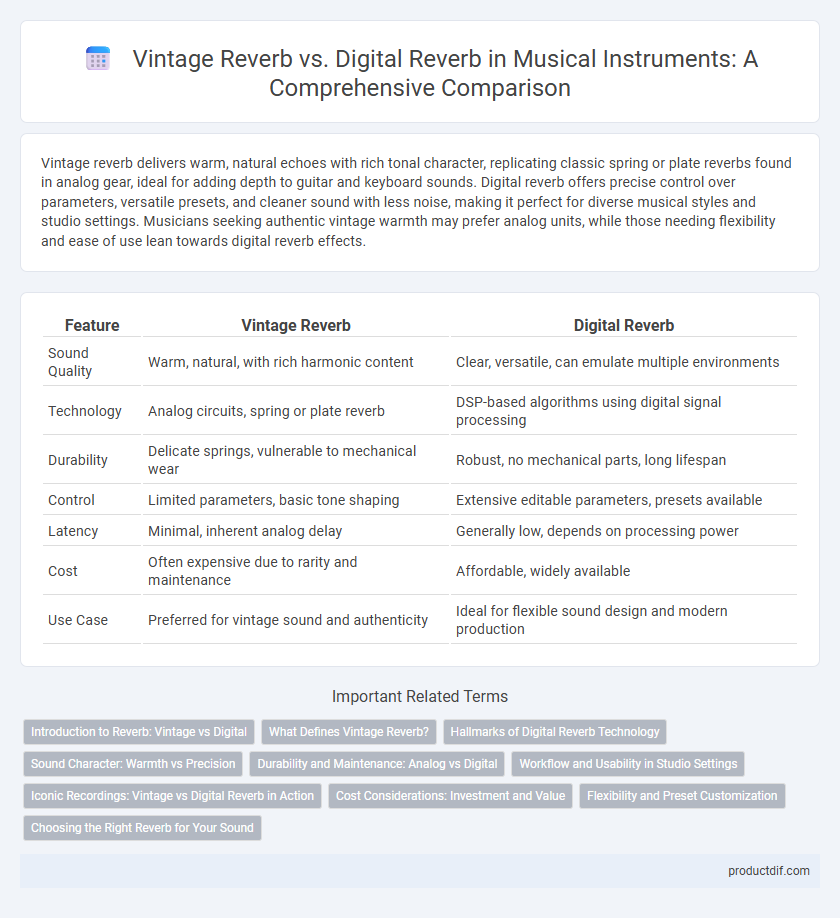Vintage reverb delivers warm, natural echoes with rich tonal character, replicating classic spring or plate reverbs found in analog gear, ideal for adding depth to guitar and keyboard sounds. Digital reverb offers precise control over parameters, versatile presets, and cleaner sound with less noise, making it perfect for diverse musical styles and studio settings. Musicians seeking authentic vintage warmth may prefer analog units, while those needing flexibility and ease of use lean towards digital reverb effects.
Table of Comparison
| Feature | Vintage Reverb | Digital Reverb |
|---|---|---|
| Sound Quality | Warm, natural, with rich harmonic content | Clear, versatile, can emulate multiple environments |
| Technology | Analog circuits, spring or plate reverb | DSP-based algorithms using digital signal processing |
| Durability | Delicate springs, vulnerable to mechanical wear | Robust, no mechanical parts, long lifespan |
| Control | Limited parameters, basic tone shaping | Extensive editable parameters, presets available |
| Latency | Minimal, inherent analog delay | Generally low, depends on processing power |
| Cost | Often expensive due to rarity and maintenance | Affordable, widely available |
| Use Case | Preferred for vintage sound and authenticity | Ideal for flexible sound design and modern production |
Introduction to Reverb: Vintage vs Digital
Vintage reverb produces warm, natural echoes using analog spring or plate mechanisms, favored for its rich, organic sound commonly found in classic recordings. Digital reverb employs algorithms and digital signal processing to simulate various acoustic environments with precise control and versatility across genres. Musicians often choose vintage reverb for its authentic tonal character, while digital reverb offers customizable effects tailored to modern production needs.
What Defines Vintage Reverb?
Vintage reverb is defined by its analog circuitry and mechanical components, such as spring tanks or plate reverbs, which produce warm, natural decay with rich harmonic overtones. These units often feature distinctive tonal coloration and unique character that digital algorithms strive to emulate but rarely replicate perfectly. Musicians and producers favor vintage reverb for its organic sound texture and the subtle imperfections that add depth and authenticity to recordings.
Hallmarks of Digital Reverb Technology
Digital reverb technology is characterized by precise control over decay times, pre-delay, and diffusion parameters, enabling versatile sound shaping unattainable with vintage units. The use of algorithms and high-resolution audio processing allows for consistent, noise-free reverberation that can replicate various acoustic environments. Modern digital reverbs often include customizable presets, multi-channel support, and integration with MIDI, enhancing their application in both studio and live performance settings.
Sound Character: Warmth vs Precision
Vintage reverb units deliver a warm, rich sound characterized by natural decay and organic tonal qualities, often sought after for their musicality and depth. Digital reverb provides precise control over parameters, producing clean, clear reflections that maintain transparency and versatility across genres. Musicians favor vintage reverb for its lush ambiance, while digital reverb excels in replicating diverse acoustic spaces with consistent accuracy.
Durability and Maintenance: Analog vs Digital
Vintage reverb units, often built with analog components like springs and tubes, offer robust durability but require regular maintenance due to wear and tear on mechanical parts. Digital reverb devices feature solid-state construction with no moving parts, resulting in higher reliability and minimal upkeep over time. Musicians valuing longevity and low maintenance typically prefer digital reverb for consistent performance, while analog enthusiasts accept frequent servicing for authentic vintage sound.
Workflow and Usability in Studio Settings
Vintage reverb units offer tactile controls and a distinct analog warmth favored for hands-on adjustment during recording sessions, enhancing creative workflow for producers seeking classic effects. Digital reverb devices provide extensive presets and automation capabilities, streamlining integration within digital audio workstations (DAWs) and enabling precise recall for efficient project management. Studio environments benefit from combining vintage and digital reverbs to balance intuitive manipulation with modern versatility and recallability.
Iconic Recordings: Vintage vs Digital Reverb in Action
Vintage reverb units, such as the EMT 140 plate and the Spring reverb in Fender amps, shaped iconic recordings like Pink Floyd's "Wish You Were Here" and The Rolling Stones' "Start Me Up" with their warm, natural decay and analog character. Digital reverb, exemplified by devices like the Lexicon 480L, revolutionized studio production in the 1980s and beyond, offering precise control and lush, complex reverberation heard in Michael Jackson's "Thriller" and U2's "With or Without You." The choice between vintage and digital reverb remains influential in defining a recording's spatial texture and emotional impact.
Cost Considerations: Investment and Value
Vintage reverb units typically demand higher initial investments due to rarity and analog circuitry, often appreciated by collectors and audiophiles valuing warm, natural sound. Digital reverb offers cost-effective solutions with diverse preset options and minimal maintenance, appealing to budget-conscious musicians and producers seeking versatility. Evaluating long-term value involves balancing vintage uniqueness against digital reliability and expanded sonic capabilities.
Flexibility and Preset Customization
Vintage reverb units typically offer limited flexibility and basic preset customization, relying on analog circuitry that delivers warm and natural reflections but fewer user-adjustable parameters. Digital reverb processors provide extensive flexibility with numerous presets and advanced customization options, enabling precise control over decay, modulation, and spatial characteristics. Musicians seeking tailored soundscapes prefer digital reverbs for their adaptability, while purists value vintage units for their distinct, organic tonal qualities.
Choosing the Right Reverb for Your Sound
Vintage reverb delivers warm, organic tones with natural decay characteristics prized in classic recordings, while digital reverb offers versatile sound shaping with precise control and a wide range of algorithms. Choosing the right reverb depends on the desired sonic texture: vintage units excel in producing lush, authentic ambience, whereas digital units provide flexibility for modern soundscapes and genre adaptability. Musicians seeking vintage warmth might prefer spring or plate reverbs, whereas producers desiring parameter customization often select digital effects processors or software plugins.
Vintage reverb vs Digital reverb Infographic

 productdif.com
productdif.com